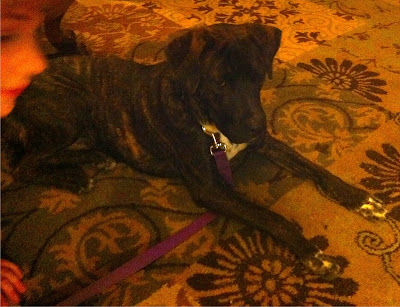symptom n. an abnormality caused by a disease that is observable in a sick animal
Source: Dictionary of Veterinary Terms: Vet-speak Deciphered for the Non-veterinarian
The above definition points out two important things. A symptom is an
abnormality that can be
observed.
As far as your dog's health is concerned, this is the most important part of your job. You're the one who needs to pick up on such things. Well, of course you know
that, that is a no-brainer, isn't it? You would be surprised how often it is not.
Observing doesn't necessarily mean understandingRoxanne Hawn of
Champion of My Heart wrote a great heartfelt article on the subject,
Fearful Dog's and Medical Warning Signs. Sometimes we get so used to certain existing abnormalities, such as fear, that it is very easy to miss their medical significance.
If you had a confident dog, who suddenly became fearful, you're likely to take notice. But what if your dog is
already fearful?
Your dog might be fearful, he might be quiet, he might be reactive … it is knowing what is
normal for
your dog that is important.
Knowing what is normalKnowing what is normal requires truly knowing your dog. Nobody else can do this for you.
Some symptoms are hard to miss because they hit you right in the face. Explosive
diarrhea,
vomiting,
bleeding, severe
itchiness...
But symptoms are not always as obvious. That doesn't mean that they are any less important.
As in
Lilly's case, there was increase in fearfulness. But things like
summertime increase in fears is
normal for Lilly. Then there was some decrease in activity and stamina. Hiding behavior and change in elimination habits. Hair loss...
Beware of racionalizationsI think it is our tendency to nurture denial. Decrease in activity and stamina is easily attributed to weather, being tired from _______ (fill in your racionalization), or simple aging. “He just matured and slowed down.” There is no such thing in dogs, my friend! Dogs don't slow down because they matured, they slow down because being active had become difficult and/or accompanied by
pain.
Even pain is sometimes considered
normal in a senior dog!
When I joined hubby and our guys at the friend's farm recently, it was just couple days after Jasmine started favoring her front left leg again. I was upset about it and we had an appointment scheduled with her
chiropractor.
The friend was complimenting on how great Jasmine was looking (and she was) and how well she was doing. I agreed but noted I was concerned about her front left leg.
“Well, she's eight years old,” the friend said.
Yes, she is, but she was eight ears old three days ago too and was pain free!
Just because a dog gets older it doesn't mean they won a frequent-flyer-pain-card!Pain is not normal at any age! Pain is a symptom and needs to be addressed. Slowing down, not wanting to jump up on the couch, reluctance to play ... are not signs of maturity, they are symptoms of pain.
JD's buddy at the farm, Griffin, used to be his play buddy since JD was a pup. They'd play and play all day until they'd drop. Griffin is a Labradoodle and he is 6 years old now. He suddenly doesn't want to play with JD any more (which is breaking JD's heart).
What do you think? Had Griffin became too mature for silly play or should he be examined for signs of
arthritis or other health problem?
The frog in boiling waterGradual changes are the hardest to notice. Because they happen a little bit at the time they kind of became the
new normal. Just like the frog placed in cold water that is slowly heated will not jump out. It doesn't work out so great for the frog!
Any signs that could be attributed to aging should be examined.I think using what your dog was like when they were younger can serve as a good baseline. Symptoms of
arthritis,
Cushing's disease … are all too often contributed to aging.
Straight out denialdenial n. refusal to admit the truth or reality
Source: Merriam-Webster
Nobody wants bad things happen to their dog. Denial is really hoping that what you're seeing isn't what you fear it might be.
The first time Jasmine got up and was
limping on her rear left leg, both hubby and I hoped her leg just
fell asleep. Maybe her leg just fell asleep. Maybe she just laid wrong. Maybe she's just a little stiff. Hubby, eternal optimist, God bless his soul, is always trying to offer one of these explanations. But experience taught me otherwise.
Beware of “maybe it's just” explanations for what you're seeingMaybe it's just heat was the first thought of Duncan's parents when he became
lethargic and listless. Three days later he collapsed upon arrival to the emergency hospital and was diagnosed with
Immune Mediated Hemolytic Anemia (IMHA).
Our neighbor's though it was just the heat
when their dog collapsed. He died at the emergency hospital of heart failure.
Even
just the heat can be deadly for your dog!
Know what is normal for your dog!Know what is normal for your dog. Note and acknowledge any deviations from it. Noticing and addressing early symptoms can make a world of difference, and, in some cases, it can mean the difference between life and death.
Resist denial and racionalizations. The only way to deal with a problem is by facing it. And if by some chance you do end up in the veterinarian's office with a false alarm, trust me, it's the better alternative.
It's your dog's health,
Jana
Related articles:
Where There Is Smoke, There Is Fire: A Symptom Is Your Friend, Treat It With Respect! When Is It an Emergency?Help! My Dog Is Purple!A Word On Pain It's Your Dog's Health

























